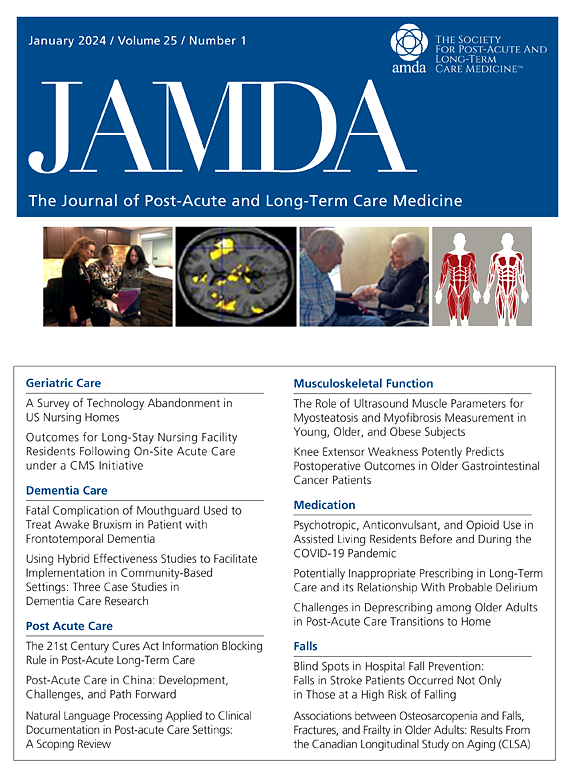A Narrative Review of Physical Performance Changes in Dementia: Differences between Community and Nursing Home Setting
IF 4.2
2区 医学
Q2 GERIATRICS & GERONTOLOGY
Journal of the American Medical Directors Association
Pub Date : 2025-05-14
DOI:10.1016/j.jamda.2025.105614
引用次数: 0
Abstract
Objectives
To investigate differences in longitudinal physical performance in individuals with dementia across care settings.
Design
Narrative review.
Setting and Participants
Older adults with moderate to severe dementia residing in the community or nursing home.
Methods
A systematic literature search was conducted in PubMed, Embase, and Web of Science. Included studies were longitudinal, with observational or care-as-usual control groups, with a follow-up ≥3 months, assessing physical performance in adults aged ≥65 years with dementia (Mini Mental State Examination score ≤20), in the community or nursing home setting. Eligibility screening and risk of bias were performed by 2 authors. We categorized physical performance-based tests into upper limb strength, lower limb strength, balance, endurance, flexibility, mobility, and combined physical performance. Physical performance changes were quantified within each study as percentage of change from baseline to follow-up, and were compared between community and nursing home setting using narrative synthesis.
Results
The search yielded 7813 studies, of which 20 were included (15 from nursing homes). Five of 20 studies were classified as having high risk of bias. In the nursing home setting, physical performance decline was observed across all domains (3- to 4-month follow-up: −6.1% to −7.7%, 5- to 7.5-month follow-up: −4.6% to −30.7%, 12- to 36-month follow-up: −27.3% to −68.2%). In the community setting, only combined physical performance declined (12–24 months: −18.6% to −33.8%).
Conclusions and Implications
Studies assessing longitudinal physical performance in the community and nursing home setting were identified and summarized. Physical performance declined after shorter follow-up periods across all domains in the nursing home setting, whereas in the community setting only combined physical performance declined. However, diversity in study characteristics, study populations and outcome measures, along with a deficiency of longer follow-up periods in the community setting, hamper interpretation. Future research should focus on physical performance trajectories in longitudinal within-group designs of community-dwelling individuals with dementia who transition to nursing homes.
痴呆患者身体表现变化的叙述性回顾:社区与养老院环境的差异
目的探讨不同护理环境下痴呆患者纵向身体表现的差异。DesignNarrative审查。环境和参与者:居住在社区或养老院的中度至重度痴呆成年人。方法在PubMed、Embase、Web of Science中进行系统的文献检索。纳入的研究是纵向的,观察组或照护对照组,随访≥3个月,评估≥65岁痴呆患者(Mini精神状态检查评分≤20)在社区或养老院环境中的身体表现。资格筛选和偏倚风险由2位作者进行。我们将基于体能表现的测试分为上肢力量、下肢力量、平衡、耐力、灵活性、机动性和综合体能表现。在每项研究中,身体表现的变化被量化为从基线到随访的变化百分比,并使用叙事综合方法比较社区和养老院设置。结果共检索到7813项研究,其中包括20项研究(15项来自养老院)。20项研究中有5项被归类为高风险偏倚。在养老院环境中,所有领域的身体表现都有所下降(3至4个月的随访:- 6.1%至- 7.7%,5至7.5个月的随访:- 4.6%至- 30.7%,12至36个月的随访:- 27.3%至- 68.2%)。在社区环境中,只有综合体能表现下降(12-24个月:−18.6%至−33.8%)。结论和意义对社区和养老院环境下的纵向身体表现评估研究进行了识别和总结。在疗养院环境中,在较短的随访期内,所有领域的身体表现都有所下降,而在社区环境中,只有综合身体表现下降。然而,研究特征、研究人群和结果测量的多样性,以及在社区环境中缺乏较长的随访期,阻碍了解释。未来的研究应该关注社区居住的痴呆症患者过渡到养老院的纵向组内设计的身体表现轨迹。
本文章由计算机程序翻译,如有差异,请以英文原文为准。
求助全文
约1分钟内获得全文
求助全文
来源期刊
CiteScore
11.10
自引率
6.60%
发文量
472
审稿时长
44 days
期刊介绍:
JAMDA, the official journal of AMDA - The Society for Post-Acute and Long-Term Care Medicine, is a leading peer-reviewed publication that offers practical information and research geared towards healthcare professionals in the post-acute and long-term care fields. It is also a valuable resource for policy-makers, organizational leaders, educators, and advocates.
The journal provides essential information for various healthcare professionals such as medical directors, attending physicians, nurses, consultant pharmacists, geriatric psychiatrists, nurse practitioners, physician assistants, physical and occupational therapists, social workers, and others involved in providing, overseeing, and promoting quality

 求助内容:
求助内容: 应助结果提醒方式:
应助结果提醒方式:


